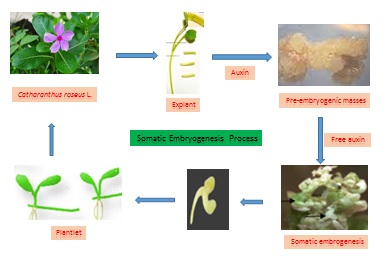The induction and development of somatic embryos from the in vitro culture of Catharanthus roseus (L.) G. Don

Published 2021-02-01
Keywords
- Catharanthus roseus (L.) G. Don,
- MS,
- PGR,
- somatic embryogenesis
How to Cite
Copyright (c) 2021 Mohammad Ali Aazami

This work is licensed under a Creative Commons Attribution 4.0 International License.
Abstract
Catharanthus roseus is containing anticancer alkaloids vincristine and vinblastine as is an important medicinal plant. Several studies have conducted on in-vitro culture of this plant. To optimize the somatic embryogenesis, a factorial based on CRD experiment with 10 replications was conducted. Root, hypocotyl and leaf explants grown in-vitro were transferred and cultured on MS media containing different combinations of 2,4-D, NAA and 2,4-D×BAP. The results revealed that in callogenesis, the interaction effects of root and hypocotyl explants×2,4-D and NAA as well as hypocotyl×(1 mg l-1 NAA+1 mg l-1 BAP) was superior than other treatments (p≤0.01). For calli fresh weight, hypocotyl×NAA and hypocotyl×(1 mg l-1 NAA+1 mg l-1 BAP) was the treatment of choice (p≤0.01). The calli produced were sub-cultured to attain the pre-embryos and somatic embryos. For the number of pre-embryos and somatic embryos; the interaction of hypocotyl×2,4-D was the best and most efficient treatment. Seemingly, the production of somatic embryos is accessible in this plant by the logical management of growth regulator combinations. Furthermore, the production and genetic engineering of the somatic embryos could be a promising trend in the subsequent production of high-valued metabolites from this plant.




